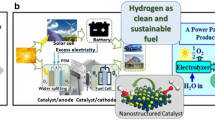Abstract
Exhaustive indole oxidation in aqueous solution was studied using contact glow discharge plasma. The results indicated that the rate of indole degradation increases with the decrease in the solution conductivity. The degradation rate can be enhanced under the following situations. First, the increase in temperature. Second, introduce active carbon and hydrogen peroxide to the solution. Third, the degradation process is performed in alkaline or acidic media rather than the neutral media. Fourth, add Fe2+ to solution to undergo Fenton’s reaction. However, n-butanol was found decelerate the degradation of indole. Some major intermediates produced during the degradation were detected by using both HPLC and GC-MS.






Similar content being viewed by others
References
Gregory V, Korshin JK, Gan L (2006) Comparative study of reactions of endocrine disruptors bisphenol A and diethylstilbestrol in electrochemical treatment and chlorination. Water Res 40:1070
Abramov V, Abramov O, Gekhman A, Kuznetsov V, Price GJ (2006) Ultrasonic intensification of ozone and electrochemical destruction of 1, 3-dinitrobenzene and 2, 4-dinitrotoluene. Ult Sonochem 13:303
Essam T, Amin MA, Tayeb O, Mattiasson B, Guieysse B (2007) Sequential photochemical-biological degradation of chlorophenols. Chemosphere 66:45
Gai K (2006) Aqueous benzoquinone degradation induced by plasma with glow discharge electrolysis, Cana. J Aana Sci Spect 51:181–186
Sharma AK, Josephson GB, Camaioni DM, Goheen SC (2000) Destruction of pentachlorophenol using glow discharge plasma process. Environ Sci Technol 34:2267–2272
Sun B, Sato M, Harano A, Clements JS (1998) Non-uniform pulse discharge-induced radical production in distilled water. Environ J Electrostat 43:115–126
Chen Y, Zhang X, Dai Y, Yuan W (2004) Pulsed high-voltage discharge plasma for degradation of phenol in aqueous solution. Sep Pur Technol 34:5–12
Sun B, Sato M, Clements JS (2000) Oxidative processes occurring when pulsed high voltage discharge degrade phenol in aqueous solution. Environ Sci Technol 34:509–513
Sugiarto AT, Ito S, Ohshima T, Sato M, Skalny J (2003) Oxidative decoloration of dyes by pulsed discharge plasma in water. J Electrostat 58:135–145
Kraft A, Stadelmann M, BlaschkeJ M (2003) Anodic oxidation with doped diamond electrodes: a new advanced oxidation process. Hazard Mater B 103:247–261
Marselli B, Garacia-Gomez J, Michaud P-A (2003) Electrogeneration of hytroxyl radicals on boron-doped diamond electrodes. J Electrochem Soc 150:D79
Katsuki N, Takahashi E, Toyoda M, Kurosu T, Iida M, Wakita S, Nishiki Y, Shimamune T (1998) Water electrolysis using diamond thin-film electrodes. J Electrochem Soc 145:2358
Rodrigo MA, Michaud PA, Duo I (2001) Oxidation of 4-Chlorophenol at boron-doped diamond electrode for wastewater treatment. J Electrochem Soc 148:D60
Iniesta J, Michaud PA, Panizza M, Cerisola G, Aldaz A, Comninellis C (2001) Electrochemical oxidation of phenol at boron-doped diamond electrode. Electrochem Acta 46:3573
Malik MA, Ghaffar A, Malik SA (2001) Water purification by electrical discharges. Plasma Sourc Sci Technol 10:82
Sengupta SK, Singh R, Srivastava AK (1998) A study on non-faradaic yields of anodic contact glow discharge electrolysis using cerous ion as the OH scavenger: an estimate of the primary yield of OH radicals. Indian J Chem 37A:558
Tezuka M, Iwasaki M (1998) Plasma induced degradation of chlorophenols in an aqueous solution. Thin Solid Films 316:123–127
Tezuka M, Iwasaki M (2001) Plasma-induced degradation of aniline in aqueous solution. Thin Solid Films 386:204–207
Grymonpre DR, Sharma AK, Finney WC, Locke BR (2001) The role of Fenton’s reaction in aqueous phase pulsed streamer corona reactors. Chem Eng J 82:189–207
Gai K, Dong Y (2005) Plasma induced degradation of azobenzene in water. J Chin Chem Soc 52:273–276
Gai K, Dong Y (2005) Liquid phase auramine oxidation induced by plasma with glow discharge electrolysis. Plasma Sourc Sci Technol 14:589–593
Hase H, Haradar K (2001) Esp detection OH and H radicals generated by contact glow discharge in aqueous. Viva Origino 29:63–65
Foti G, Gandini D, Comninellis C, Perret A, Haenni W (1999) Electrochem, oxidation of organics by intermediates of water discharge on IrO2 and synthetic diamond anodes. Electrochem Solid State Lett 2:228
Gai K (2009) Anodic oxidation with platinum electrodes for degradation of p-xylene in aqueous solution. J Electrostat 67:554
Hickling A, Linacre JK (1954) The anodic oxidation of ferrous sulphate. J Chem Soc 711–719
Dewhurst HA, Flagg JF, Watson PK (1959) Oxidation of aqueous ferrous sulfate by glow discharge. J Electrochem Soc 106:366–367
Acknowledgments
We acknowledge the School of GANSU Province Graduate Student Teacher Research Item Project Stake (No. 0910-04).
Author information
Authors and Affiliations
Corresponding author
Rights and permissions
About this article
Cite this article
Gai, K., Qi, H., Zhang, Y. et al. Degradation of indole in aqueous solution using contact glow discharge plasma. J Appl Electrochem 40, 615–619 (2010). https://doi.org/10.1007/s10800-009-0036-7
Received:
Accepted:
Published:
Issue Date:
DOI: https://doi.org/10.1007/s10800-009-0036-7




